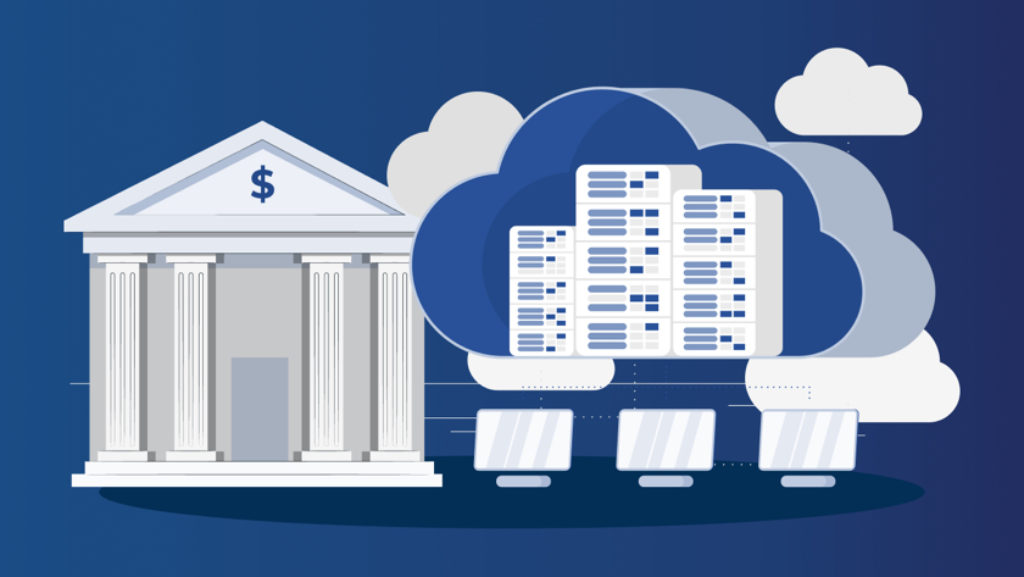Table of Contents
Big Data is a valuable asset for companies across all industries as part of their digitization strategy. However, the financial industry for a long time remained quite hesitant about implementing new, innovative technologies.
But today, the banking industry seems to have fully embraced big data and uses it to serve customers in a more efficient manner and to keep up with changing trends and requirements. This article describes the biggest use cases of big data for banks as well as the major challenges that companies face when deciding to implement business analytics.

What is Big Data in a nutshell?
While there is no single definition of big data, we can define it as complex and varied data sets that consist of various information types and are too massive to be processed by traditional tools. Hence, big data processing requires the use of specific business analytics tools as well as innovative technologies like Machine Learning.
Getting back to the big data, there are three main types of it:
- Structured: the data is well-organized and exists in a unified, fixed format;
- Unstructured: the information is stored in various formats and is not organized;
- Semi-structured: the information can be both structured and unstructured.
The reason for these types to exist is that big data consists of information collected from multiple and various sources. Hence, a company may own various types of information, depending on its approach towards information collection and storage.
As for the characteristics of big data, its size is not the only feature that makes it different from a regular data set. There are four key characteristics of big data:
- Volume: implies the enormous size of the data;
- Variety: means big data consists of various data types (see above) and is heterogeneous;
- Velocity: implies high speed of data generation and its continuous flow;
- Variability: means there is a possibility of information inconsistency due to various sources.
If we look at examples of big data for banks, they include one’s spending patterns, credit information, demographic information, financial position, or social media behavior. And banks and financial institutions generate such kinds of information on a regular basis.
Now the question is: how does big data really help in banking and what tangible benefits does it bring?
Big Data for banks: the biggest use cases
The ultimate goal of any organization is to attract and retain customers and encourage them to complete conversions. With the help of big data, the banking industry now has a perfect chance to optimize its services, boost customer satisfaction, and keep up with arising FinTech startups.
Customer segmentation and profiling
It is essential to know and understand who your customers are in order to effectively server them. For a long time, banks and financial institutions used limited and basic information (i.e. demographics) to create customer profiles.
Now, thanks to the Internet and the availability of data-collection tools, banks can gather all sorts of information about their customers and use it in order to create highly accurate customer portraits. This, in turn, leads to accurate customer segmentation. And granular customer segmentation assists with the following:
- More accurate and relevant marketing campaigns;
- Knowledge of one’s behavior, needs and wants;
- Analysis of one’s financial habits;
- Reduced chances of proposing wrong offers.
In short, customer segmentation helps banks create highly detailed portraits of their customers and use them to plan marketing activities and further interactions with customers.
Personalized experience
In relation to the point above, big data can help banks take their customer service to the brand-new level through highly personalized customer experience.
By knowing what each customer exactly wants, financial institutions can provide highly relevant offers and predict one’s needs. And there is no need to remind you how much personalization matters these days. For instance, approximately 70% of customers claim that personalized offers are highly important to them when it comes to banks and financial services. However, only 14% of customers feel like they receive enough personalization. One of the reasons for that is outdated technology, according to Deloitte. Thus, the adoption of analytics platforms and machine learning may instantly take one’s financial company to the next level and make it immediately stand out from the competition.
And obviously, better customer segmentation and personalization can help banks improve their up-selling and cross-selling strategies. The more the banks know about their clients, the better options they identify to effectively sell a product or service.
Risk management
Risk management is a big and critical part of any business within the industry of finances, and big data can significantly help you here. By collecting and analyzing historical information and by using corresponding predictive analytics tools, a company can assess and forecast possible risks. And by knowing about risks in advance, it becomes much easier to prevent or mitigate them.
There are various risk management use cases for the big data in financial services:
- Vendor Risk Management: by analyzing the available information, financial institutions can better assess their vendors and the severity of possible risks. In this way, organizations can indemnify themselves against threats in advance and minimize the chances of fraudulent behavior.
- Fraud prevention: when you use machine learning tools for your big data analysis, you can easily detect suspicious activity that usually leads to fraud. This allows companies to timely react to any possible risk and eliminate it before any serious damage is done.
- Churn detection: with the help of an appropriate risk management tool, financial institutions can analyze customers’ behavior and, hence, identify the possibility of churn at an early stage. Churn detection will, in turn, positively affect the retention rate as banks will be able to timely take necessary actions.
As you can see, the use of big data for financial services can help banks significantly cut down their financial losses that usually happen if you don’t treat risks right. But obviously, banks need to adopt corresponding analytics tools in order to make the most out of their information – more on that below.
Growth acceleration
As McKinsey puts it, the use of big data in banking promotes organizational growth and enhanced productivity. If a bank creates detailed customer profiles and builds its marketing strategy around them, it will inevitably bring profit and will result in growth. The reason for that is that customers will be more willing to buy since the bank will provide them with value and will offer something of interest.
Data Analytics in the Telecom Industry: Use Cases, Challenges, and Trends
What stops banks and financial institutions from adopting banking analytics?
Despite all the benefits that big data brings to the financial industry, many institutions and banks are still hesitant about adopting digitization. There are several reasons for that – let’s have a closer look at them.
Outdated software
We’ve already stated that, as per McKinsey, outdated software is among the top reasons why financial organizations are unwilling to adopt innovative technologies, including banking analytics. In order to do so, a bank would have to redesign its existing system to make it compatible with the needed software solution. And this might take too much time and resources.
Lack of needed resources
Proper information processing requires many resources, including specific specialists (like data scientists), implementation (and sometimes development) of an ML model for information processing and analysis, and implementation of the selected analytics solution. Add to that the fact that an organization needs to have a scalable and robust infrastructure – and you will understand why many banks consider the process too cumbersome.
Lack of needed compliances
Financial institutions are subject to many regulations, such as GDPR, FINRA, or FinCEN. Hence, in order to effectively use the selected software, banks first need to prove they are compliant with all needed regulations. Once again, it might take too much time and resources to establish all needed procedures and successfully implement them.
Lack of short-term results
As some experts believe, one of the reasons why banks are so slow with the adoption of technological innovations is that they do not see short-term results. It might take more than 5 years to start receiving sufficient ROI from implementing a single software solution, and for some organizations, the wait is not worth it.
How can banks use big data to its fullest potential?
Though big data brings financial institutions immense benefits, we’ve mentioned the reasons why many banks and financial companies still don’t take advantage of this asset. So what does one need in order to unlock the power of the available big data?
Make sure you properly collect and store all the information
Your organization may be collecting information from numerous sources, so the first thing you need to do is identify every source and make sure the storage solution corresponds to the data type that you collect. For example, if you collect and use structured data only, you will need a data warehouse. But if you use unstructured data too, you will need a data lake.
Ensure the data is effectively processed and analyzed
To process and analyze big data for banks, you will need an effective analytics tool such as Hadoop, Apache Spark, or RapidMiner. Such tools are specifically designed for big data analytics in banking and their features allow them to handle big loads of information, cleanse and analyze them, and present the needed insights in a user-friendly manner.
Hire needed talents
Usually, work with big data requires corresponding specialists like data scientists and data engineers. While data engineers are responsible for creating the infrastructure and data pipelines, data scientists are the ones who extract the needed insights and analyze the information. Note though that these roles are usually required when a company plans to work with Machine Learning. While this technology is undoubtedly valuable, an analytics tool might be enough.
Ensure a high level of security
If you have not yet done so, we highly recommend revising your workplace security and implementing security policies that will ensure all the information within the company is safeguarded. Thus, your organization will comply with all needed regulations and will gain more trust from the clients’ side.
Expert Opinion
Big data has become a natural component in the banking and finance industry, helping to enhance client segmentation, risk management, operational efficiency, and customized services. Financial firms can use big data to create detailed customer profiles, predict client demands, and enhance their marketing strategies. However, there are also significant challenges, such as outdated technology, issues with compliance, and the need for highly skilled workers and robust security measures.
To fully fulfill the promise of big data, banks should utilize pragmatic strategies, advanced data analysis tools, and industry innovations and trends. In order to enhance the effective utilization of big data in finance, case studies that emphasize practical applications and comprehensive technical insights ought to be incorporated.
Summary
There are many use cases of big data for banks, and now is the best time to adopt it in order to remain competitive and retain customers’ interest. With digitization becoming a new standard for doing business, banks and financial organizations need to keep up with emerging fintech companies and consider strengthening their brands with new and powerful tech solutions.



Comments